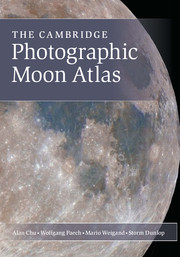Book contents
- Frontmatter
- Preface
- Advice on using this book
- Contents
- The Moon – an introduction
- Atlas of lunar formations
- 1 Mare Smythii
- 2a Mare Crisium
- 2b Mare Crisium
- 3 Cleomedes
- 4 Endymion
- 5 Atlas/Hercules
- 6 Montes Taurus
- 7 Palus Somni
- 8a Mare Fecunditatis
- 8b Mare Fecunditatis
- 9 Langrenus/Petavius
- 10 Mare Australe
- 11 Vlacq
- 12 Vallis Rheita
- 13a Mare Nectaris
- 13b Mare Nectaris
- 14 Rupes Altai
- 15 Abulfeda
- 16 Theophilus
- 17 Sinus Asperitatis
- 18 Statio Tranquillitatis
- 19a Mare Tranquillitatis
- 19b Mare Tranquillitatis
- 20a Mare Serenitatis
- 20b Mare Serenitatis
- 21 Posidonius
- 22 Lacus Mortis
- 23 Aristoteles/Eudoxus
- 24 Montes Caucasus
- 25 Autolycus/Aristillus
- 26 Cassini
- 27 Montes Alpes
- 28 Plato
- 29 Montes Teneriffe
- 30 Archimedes
- 31a Montes Apenninus
- 31b Montes Apenninus
- 32 Mare Vaporum
- 33 Rima Ariadaeus
- 34 Rima Hyginus
- 35 Sinus Medii
- 36 Hipparchus
- 37a Ptolemaeus
- 37b Ptolemaeus
- 38 Rupes Recta
- 39 Regiomontanus
- 40 Maurolycus
- 41 South Pole
- 42 Clavius
- 43 Tycho
- 44 Schiller
- 45 Palus Epidemiarum
- 46 Pitatus
- 47 Mare Nubium
- 48 Fra Mauro
- 49 Mare Cognitum
- 50 Mare Insularum
- 51a Copernicus
- 51b Copernicus
- 52 Eratosthenes
- 53a Mare Imbrium
- 53b Mare Imbrium
- 54 Sinus Iridum
- 55 Gruithuisen
- 56 Mare Frigoris
- 57 North Pole
- 58 Aristarchus
- 59 Kepler
- 60 Seleucus
- 61 Reiner
- 62 Letronne/Hansteen
- 63 Gassendi
- 64 Mare Humorum
- 65 Schickard
- 66 Sirsalis
- 67 Grimaldi
- 68 Mare Orientale
- 69 Lunar Farside
- Glossary
- Index of lunar features
- Image credits
- Further reading and references
30 - Archimedes
Published online by Cambridge University Press: 05 October 2012
- Frontmatter
- Preface
- Advice on using this book
- Contents
- The Moon – an introduction
- Atlas of lunar formations
- 1 Mare Smythii
- 2a Mare Crisium
- 2b Mare Crisium
- 3 Cleomedes
- 4 Endymion
- 5 Atlas/Hercules
- 6 Montes Taurus
- 7 Palus Somni
- 8a Mare Fecunditatis
- 8b Mare Fecunditatis
- 9 Langrenus/Petavius
- 10 Mare Australe
- 11 Vlacq
- 12 Vallis Rheita
- 13a Mare Nectaris
- 13b Mare Nectaris
- 14 Rupes Altai
- 15 Abulfeda
- 16 Theophilus
- 17 Sinus Asperitatis
- 18 Statio Tranquillitatis
- 19a Mare Tranquillitatis
- 19b Mare Tranquillitatis
- 20a Mare Serenitatis
- 20b Mare Serenitatis
- 21 Posidonius
- 22 Lacus Mortis
- 23 Aristoteles/Eudoxus
- 24 Montes Caucasus
- 25 Autolycus/Aristillus
- 26 Cassini
- 27 Montes Alpes
- 28 Plato
- 29 Montes Teneriffe
- 30 Archimedes
- 31a Montes Apenninus
- 31b Montes Apenninus
- 32 Mare Vaporum
- 33 Rima Ariadaeus
- 34 Rima Hyginus
- 35 Sinus Medii
- 36 Hipparchus
- 37a Ptolemaeus
- 37b Ptolemaeus
- 38 Rupes Recta
- 39 Regiomontanus
- 40 Maurolycus
- 41 South Pole
- 42 Clavius
- 43 Tycho
- 44 Schiller
- 45 Palus Epidemiarum
- 46 Pitatus
- 47 Mare Nubium
- 48 Fra Mauro
- 49 Mare Cognitum
- 50 Mare Insularum
- 51a Copernicus
- 51b Copernicus
- 52 Eratosthenes
- 53a Mare Imbrium
- 53b Mare Imbrium
- 54 Sinus Iridum
- 55 Gruithuisen
- 56 Mare Frigoris
- 57 North Pole
- 58 Aristarchus
- 59 Kepler
- 60 Seleucus
- 61 Reiner
- 62 Letronne/Hansteen
- 63 Gassendi
- 64 Mare Humorum
- 65 Schickard
- 66 Sirsalis
- 67 Grimaldi
- 68 Mare Orientale
- 69 Lunar Farside
- Glossary
- Index of lunar features
- Image credits
- Further reading and references
Summary
Archimedes 29.7°N, 4.0°W
Archimedes is one of the most conspicuous craters on the Mare Imbrium with a lava-flooded crater floor, and which was probably created during the early Imbrium period. The inner crater walls are stepped or terraced. The diameter of Archimedes is 82 km and the crater walls reach a height of 2.1 km above the floor. Its considerable diameter suggests that there are central peaks, but these have been completely submerged by the lava. The lava surface inside the crater appears smooth and completely level. Medium-sized instruments show, under favourable lighting conditions, two craterlets; Archimedes T, right over to the west, and Archimedes S, close to the eastern wall of the crater. Both have a diameter of just about 3 km. Large instruments show at least a dozen smaller crater pits. Stripes of bright ejecta, of unknown origin, lie across the lava surface. The ejecta melted by the impact also lies on the upper wall of the crater and gives it a thickened, rounded appearance. A prominent, triangular cape stretches out from the crater rim towards the southeast, to a distance of 30 km.
Montes Archimedes 25.3°N, 4.6°W
Montes Archimedes is a range of mountains that covers an area of about 160 × 140 km. The mountains directly adjoin the southern wall of Archimedes and, from there, run out in a southerly direction. They are a portion of the original inner wall of the Imbrium Basin, which had been heaped up to such a height that they were not submerged by the Imbrium lava.
- Type
- Chapter
- Information
- The Cambridge Photographic Moon Atlas , pp. 101 - 102Publisher: Cambridge University PressPrint publication year: 2012

